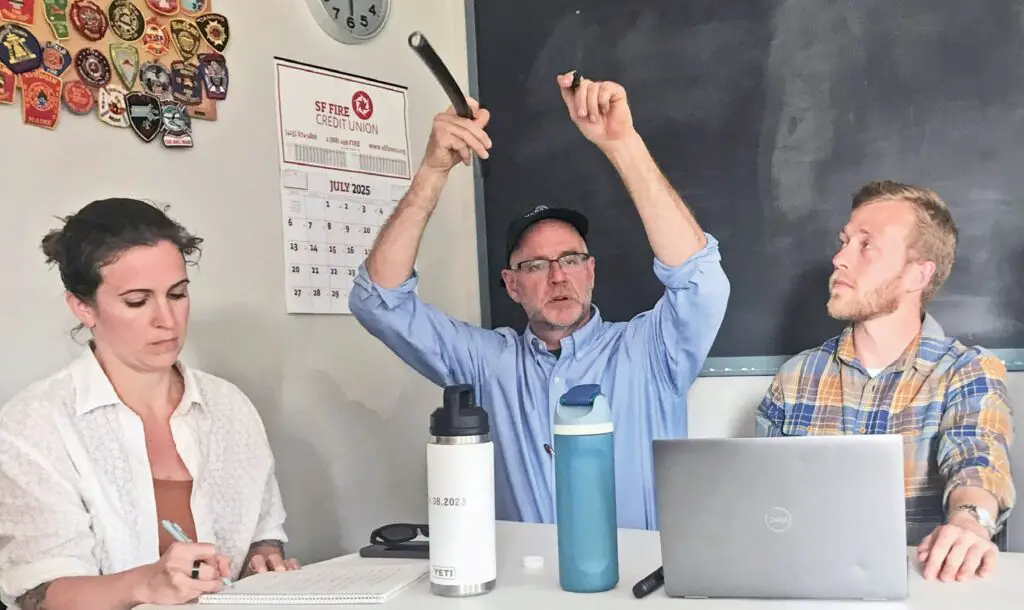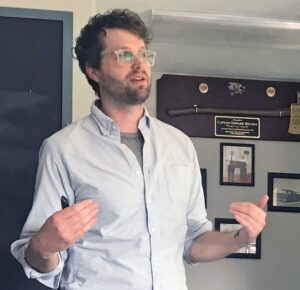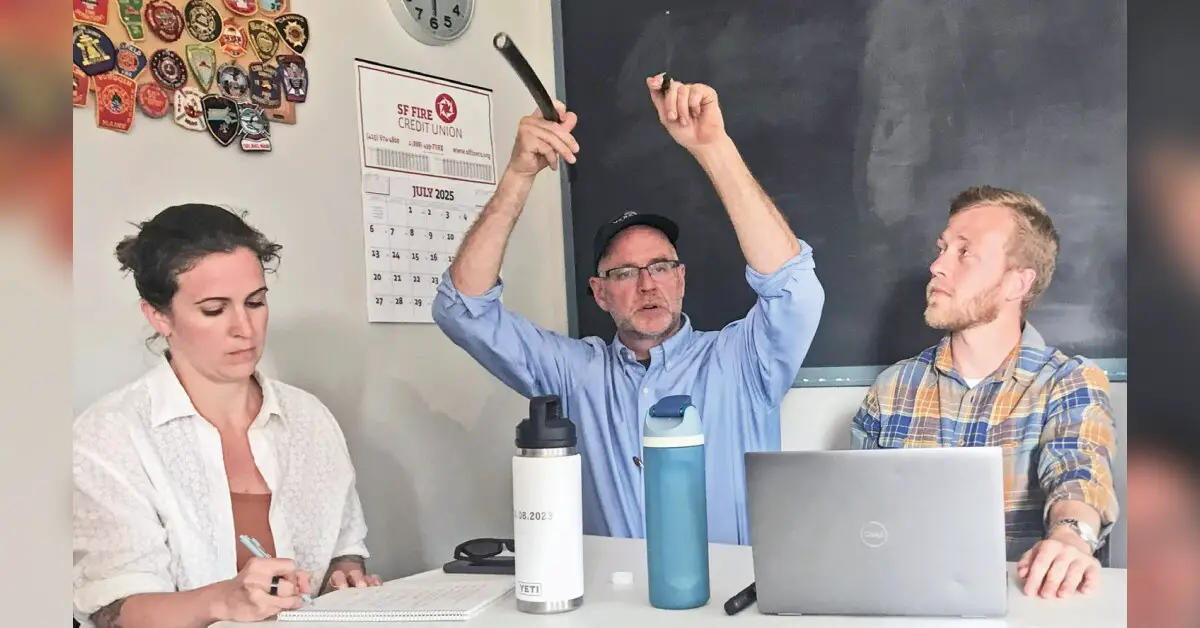
Dave Norman (center), Versant Power’s manager of regulatory support shows samples of two wires: on the right, copper wire used in power lines that is being replaced with a covered multi-wire aluminum wire. Also shown: Kate Klibansky of the Island Institute and Clayton Pokorny, researcher at National Renewable Energy Labs. PHOTOS BY TRESSA VERSTEEG
BROOKLIN—Residents in Brooklin are taking steps to make their town more energy secure in the future. Last year, the Brooklin Climate Response Committee applied and was awarded an Energy Technology Innovation Partnership Project (ETIPP) grant from the U.S. Department of Energy.
The program pairs coastal and remote communities across the country with renewable energy experts to pinpoint local energy vulnerabilities, find possible solutions, and offer technical assistance. Representatives from the National Renewable Energy Labs and the Island Institute will work with Brooklin’s ETIPP committee on this project, which includes members of the Brooklin Climate Response Committee and other Brooklinites. Lars Selberg is chair of the ETIPP committee.
About 30 people attended a presentation on July 22 at the Brooklin Fire Station where experts explained the scope of the project and plan. Clayton Pokorny, researcher at NREL, said the project’s aim is “increase access to reliable power.” He added that aging electrical infrastructure, the impact of storms, and energy costs are all challenges that Brooklin faces.

Nicholas DeForest, an engineer with the National Renewable Energy Labs, presents information about the Energy Technology Innovation Partnership Project (ETIPP) grant that Brooklin was selected for. The project will help Brooklin plan for energy security.
Nicholas DeForest, an engineer at NREL, said the ETIPP team is currently collecting a year’s worth of energy data on four municipal buildings: the Brooklin school, town hall, historical society, and fire station. As a potential solution to power outages, the group will analyze if these could be sites for a “microgrid.” For example, DeForest explained, if a storm causes a power failure in town, a solar-powered microgrid at the Brooklin School could kick on and keep the building powered with no disruption.
Another goal of the project is researching ways to strengthen the overall town grid. The group is looking into connecting the two electrical feeder circuits to town, building community solar at the former town dump, and increasing the hosting capacity of the distribution circuits.
Many questions from the audience pertained to solar infrastructure costs and feasibility, as well as the benefits and challenges of off-grid solutions. Microgrids are still part of the bigger power grid, DeForest explained. Kate Klibansky, of the Island Institute, said one advantage to a microgrid powered by solar, as opposed to a diesel generator, is that the power can continue even in the case of a fuel shortage.
One audience member asked where Versant’s power currently comes from. Dave Norman, Versant Power’s manager of regulatory support, said that about 20 percent is nuclear, 50 percent is natural gas, and 30 percent is renewable energy like solar and wind. Currently, Maine is not getting power from Quebec Hydro, he said.
Norman explained that the state’s public utility board determines where the power comes from, not Versant. Versant’s role is to distribute the power, wherever it comes from, safely, and keep the grid’s voltage steady and stable. If the grid power is not balanced, there is a huge risk of a surge in power damaging the system and causing a power failure. This is what happened during the blackouts in Spain this spring, Ken Colbur, a board member of Efficiency Maine, explained.
Some audience members raised the benefits and challenges of being completely off-grid. Others asked why the surplus solar at their homes could not be put back into the big grid. Norman said it’s a matter of infrastructure. “Grid following” inverters do not allow this while “grid-forming” inverters have the capability to put power back into the grid.
Others were concerned about the financial costs to the town to build this kind of infrastructure. DeForest said these concerns “are totally valid.” Part of ETIPP’s findings will be on whether any of the potential solutions will be cost-effective. “We don’t know those numbers right now,” he said, noting the research will last at least a year.
Many of the experts noted that the cost of solar battery storage is coming down in price, and the infrastructure will continue to improve as the technology develops. Norman said Versant is replacing all the copper power lines with a covered aluminum wire in the area. It will also “improve” the grid’s ability to connect to solar, as the “old copper” has been a “limiting factor.”
The Brooklin Climate Response Committee will post a video recording of the meeting to their YouTube channel and their page on the town website.

